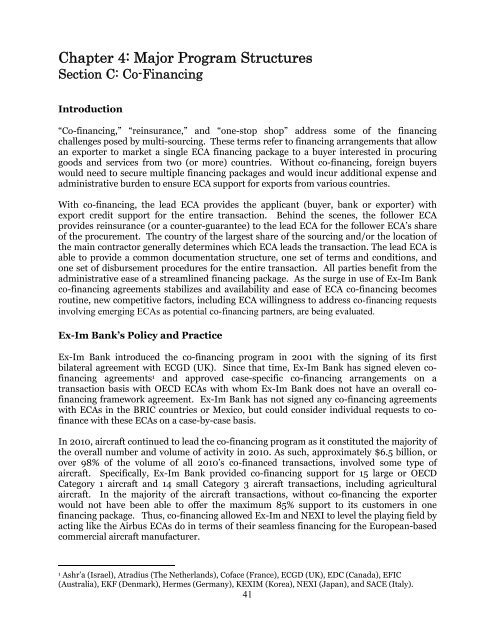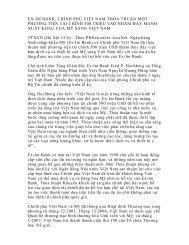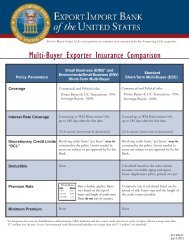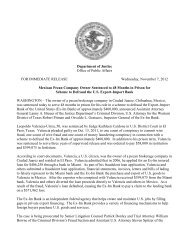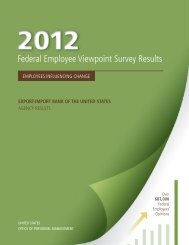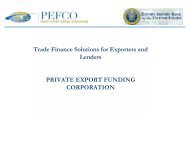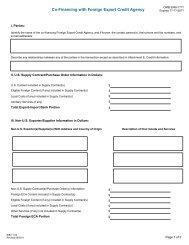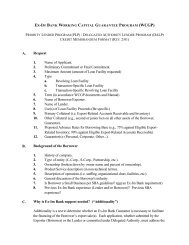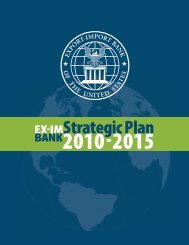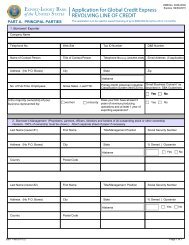2010 Competitiveness Report - Export-Import Bank of the United ...
2010 Competitiveness Report - Export-Import Bank of the United ...
2010 Competitiveness Report - Export-Import Bank of the United ...
Create successful ePaper yourself
Turn your PDF publications into a flip-book with our unique Google optimized e-Paper software.
Chapter 4: Major Program Structures<br />
Section C: Co-Financing<br />
Introduction<br />
“Co-financing,” “reinsurance,” and “one-stop shop” address some <strong>of</strong> <strong>the</strong> financing<br />
challenges posed by multi-sourcing. These terms refer to financing arrangements that allow<br />
an exporter to market a single ECA financing package to a buyer interested in procuring<br />
goods and services from two (or more) countries. Without co-financing, foreign buyers<br />
would need to secure multiple financing packages and would incur additional expense and<br />
administrative burden to ensure ECA support for exports from various countries.<br />
With co-financing, <strong>the</strong> lead ECA provides <strong>the</strong> applicant (buyer, bank or exporter) with<br />
export credit support for <strong>the</strong> entire transaction. Behind <strong>the</strong> scenes, <strong>the</strong> follower ECA<br />
provides reinsurance (or a counter-guarantee) to <strong>the</strong> lead ECA for <strong>the</strong> follower ECA’s share<br />
<strong>of</strong> <strong>the</strong> procurement. The country <strong>of</strong> <strong>the</strong> largest share <strong>of</strong> <strong>the</strong> sourcing and/or <strong>the</strong> location <strong>of</strong><br />
<strong>the</strong> main contractor generally determines which ECA leads <strong>the</strong> transaction. The lead ECA is<br />
able to provide a common documentation structure, one set <strong>of</strong> terms and conditions, and<br />
one set <strong>of</strong> disbursement procedures for <strong>the</strong> entire transaction. All parties benefit from <strong>the</strong><br />
administrative ease <strong>of</strong> a streamlined financing package. As <strong>the</strong> surge in use <strong>of</strong> Ex-Im <strong>Bank</strong><br />
co-financing agreements stabilizes and availability and ease <strong>of</strong> ECA co-financing becomes<br />
routine, new competitive factors, including ECA willingness to address co-financing requests<br />
involving emerging ECAs as potential co-financing partners, are being evaluated.<br />
Ex-Im <strong>Bank</strong>’s Policy and Practice<br />
Ex-Im <strong>Bank</strong> introduced <strong>the</strong> co-financing program in 2001 with <strong>the</strong> signing <strong>of</strong> its first<br />
bilateral agreement with ECGD (UK). Since that time, Ex-Im <strong>Bank</strong> has signed eleven c<strong>of</strong>inancing<br />
agreements 1 and approved case-specific co-financing arrangements on a<br />
transaction basis with OECD ECAs with whom Ex-Im <strong>Bank</strong> does not have an overall c<strong>of</strong>inancing<br />
framework agreement. Ex-Im <strong>Bank</strong> has not signed any co-financing agreements<br />
with ECAs in <strong>the</strong> BRIC countries or Mexico, but could consider individual requests to c<strong>of</strong>inance<br />
with <strong>the</strong>se ECAs on a case-by-case basis.<br />
In <strong>2010</strong>, aircraft continued to lead <strong>the</strong> co-financing program as it constituted <strong>the</strong> majority <strong>of</strong><br />
<strong>the</strong> overall number and volume <strong>of</strong> activity in <strong>2010</strong>. As such, approximately $6.5 billion, or<br />
over 98% <strong>of</strong> <strong>the</strong> volume <strong>of</strong> all <strong>2010</strong>’s co-financed transactions, involved some type <strong>of</strong><br />
aircraft. Specifically, Ex-Im <strong>Bank</strong> provided co-financing support for 15 large or OECD<br />
Category 1 aircraft and 14 small Category 3 aircraft transactions, including agricultural<br />
aircraft. In <strong>the</strong> majority <strong>of</strong> <strong>the</strong> aircraft transactions, without co-financing <strong>the</strong> exporter<br />
would not have been able to <strong>of</strong>fer <strong>the</strong> maximum 85% support to its customers in one<br />
financing package. Thus, co-financing allowed Ex-Im and NEXI to level <strong>the</strong> playing field by<br />
acting like <strong>the</strong> Airbus ECAs do in terms <strong>of</strong> <strong>the</strong>ir seamless financing for <strong>the</strong> European-based<br />
commercial aircraft manufacturer.<br />
1 Ashr’a (Israel), Atradius (The Ne<strong>the</strong>rlands), C<strong>of</strong>ace (France), ECGD (UK), EDC (Canada), EFIC<br />
(Australia), EKF (Denmark), Hermes (Germany), KEXIM (Korea), NEXI (Japan), and SACE (Italy).<br />
41


